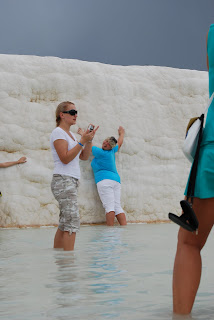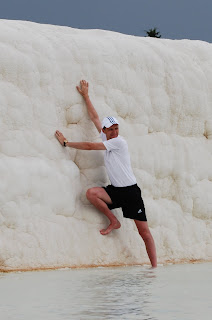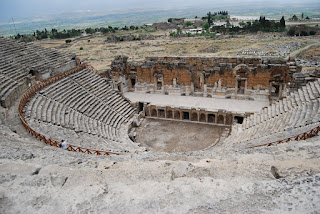Not having a GPS made us a little nervous in trying to attempt a long drive to Pamukkale from Fethiye. But after yesterday’s Oludeniz experience (nothing but a really nice beach), and time spent in Fethiye (not much beyond the waterfront), we didn’t want to spend our last full day in the south of Turkey driving to yet another coastal city to see more of the same. So despite the hotel staff’s incredulity at our desire to drive into rural Turkey, we packed our gear and headed to Pamukkale.
Pamukkale, meaning "cotton castle" in Turkish, is a city in south-western Turkey containing hot springs and and beautiful travertines, which are basically terraces formed from carbonate minerals left by the flowing water. People have bathed in its pools for thousands of years and the ruins of the old city of Hierapolis, built in 200-300 BC, can also be found here.
Not sure of the best way to get to Pamukkale, we decided to take the direct route from Fethiye, which unknown to us meant cutting across a mountain range. We knew something wasn’t right when the narrow, winding, ever climbing lane became so harrowingly tight that it would have been impossible for any tourist bus to comfortably fit on the road. What of the loads of tourists that were supposed to be heading to Pamukkale all the time? We hadn’t seen any rest stops, or restaurants, let alone the tourist buses themselves.
 Our car, with it’s puny engine, struggled mightily to climb the mountains on a road that practically disappeared from out beneath us. The markings gradually vanished, paved blacktop gave way to dusty gravel, signage vanished, and detours abounded. Saeeda and I exchanged some nervous glances, as by now we were more than 90 min. into our drive, but had no idea where we were. More worryingly, I couldn’t picture myself trying to make the same drive back at night - there was no lighting or barrier between us and steep mountain drops. What if the car broke down?
Our car, with it’s puny engine, struggled mightily to climb the mountains on a road that practically disappeared from out beneath us. The markings gradually vanished, paved blacktop gave way to dusty gravel, signage vanished, and detours abounded. Saeeda and I exchanged some nervous glances, as by now we were more than 90 min. into our drive, but had no idea where we were. More worryingly, I couldn’t picture myself trying to make the same drive back at night - there was no lighting or barrier between us and steep mountain drops. What if the car broke down?It was then that we started to hit a string of villages nestled in the crevasses that we were traversing. Life here seemed pleasantly stuck in the 20th century. Sheepherders tended their flocks in meadows, elegantly dressed old men sat by the street, engaged in obscure arguments, and grandmothers walked by the road while their grandchildren playfully ran ahead. The scenery was stunning, and the people were wonderful – we stopped often to ask directions and appreciated everyone’s help in keeping us on track. It wasn’t long after that when we finally burst out of the mountains and onto a highway again. The same highway that was being plied by tour buses galore. Yes, not only were we back on track, but we had found the highway we would take on our way back when we were done.
Pamukkale’s white cliffs appear high above you as you make it into the city, and there is another 10 min drive that takes you up to the entrance. From there all visitors are carefully funneled to the cliffs themselves. Some time back there had been so much tourist traffic that the brilliant white cliffs had started to erode, and the clear water had started to run muddy instead. Since then the government has defined where people can walk, which is just as well. The effect of suddenly sticking to a path that suddenly veers and places you before the white cliff adds to the experience.
There was understandably a lot of traffic here. The scene is surreal because you stand on these brilliantly white surfaces as you look out onto the valley before you. It’s hard to imagine how many millennia of calcium-rich spring water was needed to create the natural wonder beneath you. And the warm spring water makes it fun to wade around in the pools that form all around you. For me, the experience was enhanced, comically so, by watching the other tourists pose for pictures here. Something about this brought out the exhibitionist in everyone
And this
And then this
I decided not to snap pictures of bikini clad women who were posing as if they were auditioning for the latest Sports Illustrated Swimsuit edition – I wouldn’t have been able to come up with explanations credible enough for Saeeda afterwards. But suffice it to say that in certain parts of the cliffs it felt like we were disturbing a modeling agency’s photoshoot at times.
 The ruins of Hierapolis area walking distance from Pamukkale’s cliffs, so after grabbing lunch at “Cleopatra’s Pool”, we headed north to the well preserved ruins. The most spectacular of these was the amphitheater. Beautifully preserved, and located on a steep hill, it wasn't hard to imagine siting here as an audience member thousands of years ago, and enjoying not only the spectacle on the stage, but also the view of the white cliffs and of the valley as it fell away beneath you.
The ruins of Hierapolis area walking distance from Pamukkale’s cliffs, so after grabbing lunch at “Cleopatra’s Pool”, we headed north to the well preserved ruins. The most spectacular of these was the amphitheater. Beautifully preserved, and located on a steep hill, it wasn't hard to imagine siting here as an audience member thousands of years ago, and enjoying not only the spectacle on the stage, but also the view of the white cliffs and of the valley as it fell away beneath you.While Saeeda and Nuha sat on the steep steps and rested, I walked around, wanting to touch the old worn rock that formed the walls, and perhaps in doing so connect with the ancient civilizations that had built this place. The engineering was a marvel - sound carried effortlessly, removing the need for modern sound systems, and there truly wasn't a bad seat in the house. I climbed back up to Saeeda and Nuha, and sat down to admire the view, and to try to understand the talent of those that had built something of such great permanence.
It was then that the call to evening prayer came wafting over the air from the city of Pamukkale beneath us. I couldn't understand how, but voices of the muezzins seemed to amplify as they made their way to us. The melody was one that I'm familiar with, but it was beautiful nonetheless.
God is Great. God is Great, they called. Bear witness that there is no deity but God. Bear witness that Muhammad is his messenger. Come to salvation. Come to prayer. God is Great. There is no deity but God.
It was a spiritual moment. Just a moment ago I had been remarking on the magnificence of man-made permanence. The calls to prayer that continued to waft over me provided a stark reminder of the fallacy of my line of thought. Civilizations vanish, buildings crumble, and history fades. The only thing that remains permanent is the Force that placed things in motion, and which will be there for us to turn on the day it all comes to an end.






No comments:
Post a Comment